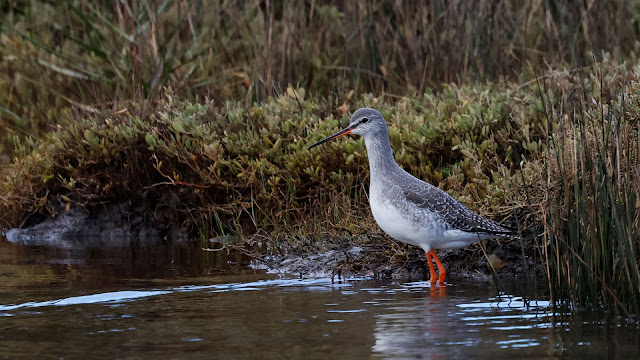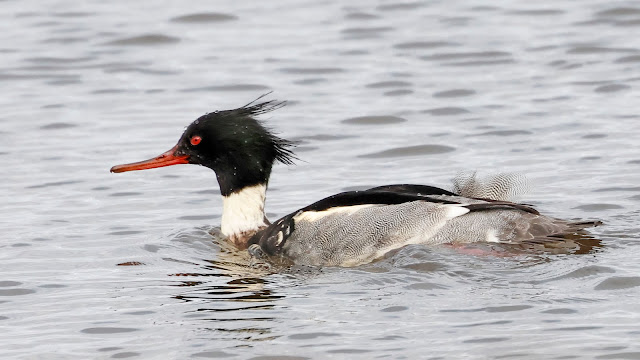Having recovered from the wedding on Saturday, I arranged to meet Ian at the seawall car park at the end of Lower Pennington Lane Sunday morning. The temperature was just above ten degrees and it was overcast to start, with some breaks in the cloud, but the westerly wind was fresh and took the edge off the mild conditions.
As we prepared ourselves a huge flock of Golden Plover appeared over the Pennington Marsh.
The flocks appeared to have lead birds forming a line around the flock and leading the other birds.
From the car park we walked across the Old Tip towards Fishtail. On reaching the Butts Lagoon we found the reported male Scaup with two male Tufted Ducks. It was gloomy so we decided to walk around Fishtail and come back to the Scaup when the light improved.
At Fishtail we picked out two Marsh Harrier at the back of the marsh and one, a large, probably female bird came around the west end of the lagoon being harassed by a Carrion Crow
The lagoon was busy with Wigeon, Shoveler, Teal and Shoveler. Waders were coming in as the tide rose, there were groups of Black-tailed Godwits and Oystercatcher scattered around the islands.
In the channel alongside the sea wall a Greenshank was around the rocks and sea weed.
It then moved out into Butts Bay.
There are several, what I call "elegant" waders, in the UK and the Greenshank along with Avocet and Spotted Redshank are amongst the best.
We walked around to the edge of Butts Bay and scanned the lagoon from the south side. There were plenty of Tufted Duck, mostly drakes, but there was no sign of the Scaup. The Shoveler were moving around going from lagoon to lagoon.
We moved on to the Jetty Lagoon where there were more Tufted Duck and amongst them was the male Scaup, or Greater Scaup to give it it's official name.
The most immediate separator of Scaup from the Tufted Ducks is the grey back. This bird no appeared still to be in moult, probably from immature plumage, with patches of brown feathers on the back which made it rather harder to pick out.
Here an opportunity to compare the similar ducks. The Tufted Duck on the left having more of a peaked head, where the Scaups is more rounded. Obviously the black back and a brighter yellow eye of the Tufted Duck.
Out over the Solent the sun was sending shards of sunlight through breaks in the cloud to light up the downs.
Walking on past the Jetty a red head Goosander was hunting in the lagoon, frequently snorkelling and rarely going completely under the water, it moved closed to the shore of the pool.
Of shore the waders were moving and they were looking to occupy any area of dry land. Here Dunlin, Grey Plover, and Knot, while scattered across the shingle were quite a few Ringed Plover.
There were several Curlew feeding at the edge of the water.
Just east of the main spit that appears after high tide and reaches out into the Solent were three Slavonian Grebes.
We walked down onto the beach and out along the spit to get a slightly better view and at water level
Walking along the spit the sun was again breaking through the cloud and lighting up the Solent.
At the end of the spit the Slavonian Grebes showed well, two though seemed to be happier together and would chase off the third bird.
The cloud was now breaking and there were patches of blue sky around us. Back on the sea wall this Little Grebe was wading through the shallow water of the Pennington Lagoon and I was taken by the blue sky reflecting on the water.
At the area around the bench at Oxey Marsh there were three Spoonbill present. One flew off almost immediately, but two remained, an adult and a an immature bird.
The adult bird, the dark bill with a yellow tip, plus the orange just showing under the chin identifying it.
And the immature bird with the all pink bill
The immature bird then promptly tucked its bill under the wing and assumed the Spoonbill position. As a result I concentrated on the adult.
Leaving the motionless Spoonbill we walked on and then stopped at the next bend where there were Dartford Warblers in the gorse and bramble. They were reluctant to show and it was a case of making sure that when they did you were focused on them.
The sun was coming out sporadically and when it did the light was wonderful as can be seen with the effect on this drake Wigeon.
Brent were constantly moving and sometimes they would come over low. As we walked alongside Salterns these two groups passed almost at eye level.
The Salterns pool is always one of the more reliable places to see Spotted Redshank, the favourite place being in the north east corner. When I was here at the start of the month one was roosting in this spot and sure enough as wee came around the bend there was one there again.
Once again, the patches of blue sky were reflecting in the water around the Spotted Redshank.
This shows well the length of the bill and the slight down turn at the tip.
We decided to get down the sea wall and approach at almost eye level. This means you have to stay close to the sea wall to avoid spooking the bird, but it is worth it for a better aspect. It also changed the colour of the water reflections.
It then settled to drink the water.
It was then upset by a Common Redshank and moved into the dark water. I mentioned earlier about the elegant waders and that the Spotted Redshank was one of those. Here you see why, the elongated neck and beautiful needle pointed bill. I also think the grey colour gives it a more elegant appearance.
Then was spooked once again by the Common Redshank. Here though there is a very good comparison of the two similarly named species. The Common Redshank more stockier, with an overall brown plumage, lacking the white belly. The Spotted Redshank, more grey, longer neck and very fine bill.
Back on the bank it stood watching us before the Redshank flew off call and consequently the Spotted Redshank had to fly off too.
All the time we had been watching the Spotted Redshank a Little Egret was stood tucked away in the corner.
We walked on to the final destination, Normandy Marsh. First up was a group of 26 Avocet roosting on the lagoon.
On one of the closest islands to the west side of the lagoon was the Bar-headed Goose.
We decided to walk around to the east side of the lagoon. There were large numbers of Pintail on the water and the many islands. Diving in the deeper parts of the lagoon was a smart male Goldeneye, but always too far away for any decent photographs.
As we came around the sea wall a Greenshank was close to the sea wall, showing very well.
There had been several Great Black-backed Gulls about and this one seemed to have found something to eat. It was though huge and the gull could only manage to drag it to a safe place. There was no clear way of identifying what it was, maybe a by catch of some sorts but you have to wonder how it turned up on the lagoon as I doubt the gull could have flown in carrying it.
The reason for coming to the east side was due to seeing a group of five Spoonbills feeding close to the sea wall. They were still there.
Synchronised feeding, but it did not seem as if the fishing was that good as the normal practice is to follow them as they sweep their bills through the water and the take the photos as they toss the catch up in the air. But they hardly ever did catch anything.
There were at three adults and two immatures and they were then joined by five more that flew in.
One of the adults.
Two together standing in the sunshine.
An immature then left and flew around the lagoon before deciding to return, coming in a low height towards me.
Flying past me and showing off the black tips on the primaries another indicator of it's immaturity.
It then came down on to the lagoon and revealed the ring with the letters and numbers NC6U. Ian and I had seen this bird back at the end of September and was a bird ringed in the Netherlands this year.
As the fishing was not that good the photos became quite samey.
Leaving the Spoonbills we made our way back, but stopped on reaching the south west corner where a pair of Red-breasted Mergansers were feeding quite close in. As always seems the way the focus is on the drake.
The water droplets on the feathers, like the divers at Redbridge, are an indication of the amazing waterproofing these birds achieve with their preening.
Snorkelling while not getting your punky feathers wet.
Also, like the divers seen earlier in the month, the red eyes that are thought to aid visibility underwater.
I did take some of the female redhead.
And the two, male and female, together.
Heading back, we stopped at Salterns once again where the Spotted Redshank had returned to the usual spot once again, the water reflections were though completely different.
Different water reflection again.
Down at a low level with this immature Oystercatcher.
Yet another break in the clouds, this time the light illuminating, or back lighting the Hurst Castle.
I realised there had not been any pictures of Pintail today.
A Peregrine put up all the waders and duck on Pennington Marsh and then flew fast across the Solent towards the Isle of Wight.
We decided we would try for the Scaup once more, the light was better. It was in the same place on the Jetty Lagoon with the Tufted Duck. It was preening so I waited and watched for it to wing flap, which it duly did.
And then settled down again on the water.
We made our way back to the cars where we had lunch watching the Golden Plover over Pennington Marsh disturbed by two Marsh Harriers that flew across where only minutes earlier we had been standing.
With the gloom setting in we decided to call it a day at about 14:00

































































































No comments:
Post a Comment